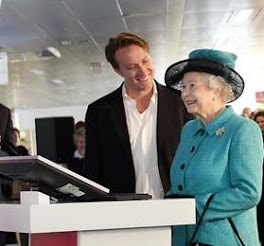The basic principle - thermal imprinting from a 3D object
(ed: things have moved on a bit since writing this post. For a more up-to-date account of my theory, see this later post, link and the one preceding it link)
ed: a lot of the step-by-step photographs have mysteriously disappeared from this post. I will endeavour to restore them ASAP.
The technique is essentially one of 'branding' (yup, as onto the hide of cattle) but the 'branding iron' was more probably a bronze statue - which did not need to be red hot to create a superficial scorch on linen.
(ed: things have moved on a bit since writing this post. For a more up-to-date account of my theory, see this later post, link and the one preceding it link)
ed: a lot of the step-by-step photographs have mysteriously disappeared from this post. I will endeavour to restore them ASAP.
The technique is essentially one of 'branding' (yup, as onto the hide of cattle) but the 'branding iron' was more probably a bronze statue - which did not need to be red hot to create a superficial scorch on linen.
This is intended as the briefest of summaries. I propose using my own comments section to flesh out the details, but only in response to queries. In the absence of comments my time is probably better spent in further experimentation (continuing the work I have described in previous posts on thermo-imprinting or thermo-stencilling).
Essence of the new model:
1. It uses a statue or bas relief of a crucified Christ - the kind of icon that would have adorned (if that is the correct term) many a medieval church or cathedral.
2. A shallow sandpit (US: sandbox) is made with fine dry (ed. or maybe moist?) sand and levelled off with a rake.
3. The sheet of linen is stretched over the top of the sand and smoothed out. The linen may have been impregnated to make it more receptive to acquiring a heat-imprinted image (think "invisible writing" that uses dried-on lemon juice or similar).
4. The statue is evenly heated in a kiln or oven until a test shows it to be hot enough to make a yellow or brown impression, i.e. 'scorch mark', on a side-sample of the linen.
(Whether one calls it a scorch or not is a matter of semantics that can be discussed later. Certainly it does not have to be hot enough to degrade or scorch bulk cellulose per se, except perhaps for a highly superficial imprint).
5. The heated statue is then placed face-down horizontally onto the linen, and pressed down lightly.
Except for awkward bits like the feet (see later) the statue is probably pressed no more than a cm or two into the sand, just sufficient to imprint as a light scorch the most prominent frontal features of the statue onto the linen, with little of the side features that might otherwise later give distortion when the cloth is removed and flattened.
The image would of course be a "negative", but that has nothing to do with photography, primitive of otherwise. The technology here is better described as thermal-imprinting by direct contact, relying mainly on heat conduction rather than radiant energy..
6. When a satisfactory image has formed of the ventral (frontal) side, the second unused half of the sheet is positioned over the newly raked sandpit, and the process repeated for the dorsal (rear) side of the statue.
7. What about the blood stains - getting them correctly positioned etc? That can be arranged by a slight modification of the procedure.
It requires a "dry run", or more correctly a "cold run". Firstly, the cold, unheated statue is pressed onto the cloth so as to penetrate the sand a little, leaving an indentation in both the sand and the linen. The statue is then carefully removed, and blood is then applied to the appropriate parts of the anatomy, as judged from the indentation. It may be left to clot and dry first. The statue is then taken away and heated, and then deposited carefully back into its original indentation to ensure consistent alignment, then pressed down a little more into the sand in order to get a good impression.
8. Created in this way, I believe the image would meet some subtle criteria that so far have not been fully achieved, e.g. in Jackson's work with his bas-relief models (see earlier post).
I believe a balance can be struck that can achieve a good compromise between a shallow bas-relief and a fully 3D statue.The compromise gives enough relief to account for 20th century "3D-encoded information" - which if the truth be told is really just an (over-hyped) analogue- to-digitized impression of 3D, ie differential scorching- to-computer-aided graduated relief. The dynamics of the pushing process, ie. - the gentle pressure on the statue, impressing it into the fabric and into the receptive cushioning sand to achieve progressively greater contact between cloth and hot metal is what helps to achieve a softer-focus more natural effect.
9. Because the statue is pressed downwards into the sand, i.e. at right angles, that would account for the so-called "directionality" of the image-forming process.
Attempting to explain the latter with radiation and projected images has been problematical, in the absence of lenses, concave mirrors, collimating systems etc., none of which are credibly medieval or indeed achievable today
10. This procedure might also explain some of the curious - or at any rate unexpected - features of the Shroud, e.g. the somewhat elongated fingers.
Those fingers (to say nothing of those "too good to be true" blood trails on forearms and that celebrated "mechanically-correct" nail wound through "wrist").
Why are the soles of the feet (even if blood-stained) so prominent in the left hand image (dorsal view), with subject's back to linen? What had been holding the linen so close and tightly apposed to them at the instant of image-imprinting? A bed of supportive sand, banked up maybe?
To get a better idea of how soles come to be imprinted, and how they look on the flattened sheet, imagine yourself lying down on a sheet with muddy boots, first with heel-only contact, then imagine you ask someone to raise and then press the end of the sheet against the muddy soles to leave an imprint. Then imagine how the imprint will look when you get up and view the flattened-out sheet from above.
Comments - premoderated - are invited, but ad hom attacks will not be tolerated (or published) If posting as "anonymous" please append an initial or two.





















7 comments:
Are you familiar with the ENEA report?
"The Shroud image is "extremely thin, one-fifth of a thousandth of a millimeter, corresponding to the thickness of the primary cell wall of a single linen fiber"
How can any branding technique (your description) make an image on linen that is so exceedingly thin, with something as unweildy as a metal statue out of an oven? Sorry but you will have to do better than this.
Well, it is branding, as with cattle, if one presses hot metal against organic material so as to leave a burn or scorch mark - there's no sense in trying to pretend otherwise. And while this may look like ancient technology, as indeed it is, and has to be, it's infinitely preferable surely to publishing papers that claim the image needs excimer laser uv light to be be reproduced in the lab (as per your ENEA ref which I have previously criticized here).
Look at my first graphic. Some of those later images after the metal had cooled down somewhat are at the limit of visibility. Who is to say they are not also one cell-wall thickness? Who's to say that any image on linen that is barely visible is not the thickness figure you cite? And that's without getting into the matter of coated/uncoated linen (the saponin story, the starch story etc etc).
It occurred to me after writing this post (I added an edit) that the dampness of the sand may be a crucial factor in avoiding an image that is too dark. If the linen is given time to pick up moisture from the sand, then bearing in mind the high latent heat of vaporisation of water (540cal/gram) most of the heat may go into evaporation, with only a little left over for chemical dehydration, crosslinking etc ("scorching"). In other words, a few wisps of steam are not a bad thing, and may help to produce a softer image. And let's not forget that linen was probably quite pricy in the 14th century - so those hoaxers could not have afforded too many botched jobs. Damp sand may have been a crucial safeguard to avoid "over-scorching" - a like using an electric iron with just a tiny amount of steam.
Could you add an initial or two if you come back again (to distinguish from other anonymice)?
Your "theory" is not a theory and cannot in any case be correct. You are saying that the image was only formed where the linen was in close contact with your hot metal. But everybody knows the shrouds image is fore-shortened with knees bent and so on. How do you explain that Mr.Sciencebod?
D
OK, D, let's not get hung up on semantics, but I think it's more than a hypothesis. Why? Because I've devised a method that in my view takes account of a lot of the facts and oddities about the image on the Shroud - like for instance it has no sides, and there is no impression of the top of the head where there is a blank portion that one expected to be in contact with the top of the head etc etc. But I won't complain if you call it a hypothesis or even a hunch. What matters is whether it can stand up to close scrutiny.
Yes, I was expecting a comment re foreshortening. It's never been clear to me how that idea that the image was foreshortened, with knees drawn up, came about. How can anyone know be sure of that if all they have is the one image, OK, two, front and rear? I cannot but help wonder if there is not some circular reasoning here - that folk assume it was a real man who was crucified, that he was still in a state of rigor mortis when placed in the Shroud, preserving the posture he had on the Cross, that the image was somehow magically projected onto a flat sheet that did not hug the comtours of the body etc etc. I don't think one should make any assumptions unless one knows the means by which the image was created, and if it was by direct contact as I suggest then it hardly matters whether the knees were or were not drawn up, and your foreshortening becomes a bit of a distraction from the real issue - was it a real body or statue? If as I believe it was the latter, then it can be heated to leave a scorch imprint - no need for Star Wars technology...
Have just this minute posted this comment to Tom Chivers' Telegraph blogsite:
Tom Chivers
Good morning Tom
Sorry, have only just spotted this latest post of yours, having been preoccupied with other (more scientific) matters - about which more in a minute.
Yup, I've made no secret in the past on what I think about Lansley and his so-called reforms, ones that turn the NHS organisational pyramid on its head, putting the gatekeepers in charge of vast spending budgets. It's a licence for a lot of people, GPs especially, to get spectacularly rich in a very short space of time with little in the way of accountability.
Changing the subject: your two recent posts on the Turin Shroud, notably on the Italian Star Wars stuff with the high energy laser beams, got this retired science bod interested in the subject, and I've been reporting a series of simple experiments in recent weeks with more down-to-earth thermo-imprinting (basically "branding" with hot metal) and thermo-stencilling (a method for trapping infrared radiation). After much thought, debate and indeed flak on a specialist site, I think I finally know how the Shroud was produced as a medieval forgery, using nothing more than an oven, a hot statue of the crucified Christ, a linen sheet and, crucially, a bed of (probably moist) sand. I call it the 'sandpit theory' and believe it is one that can account for a lot of the unusual, unexpected details re the Shroud image.
Care to take a look, and, better still, do another, third post on the Shroud, not necessarily on my humble addition to this perplexing topic?
My 'sandpit' theory:
(Link to this posting)
Interesting theory
C
Update: 1st March
I now think it was SNOW, rather than sand. Not only does snow have a lot more give than sand, it also has the added advantage of reducing the risk of excessive scorching, confining the image mainly to a superficial layer close to the area of contact between template and linen.
Post a Comment